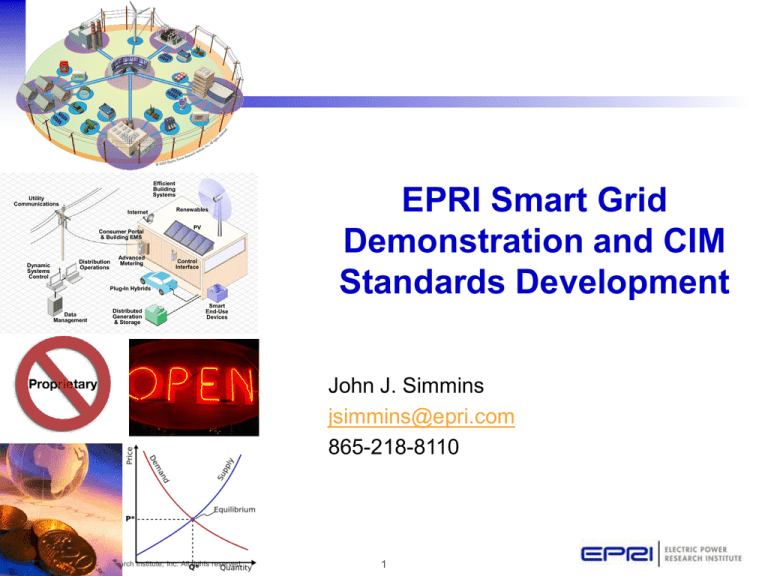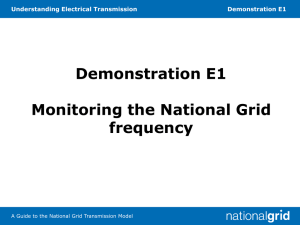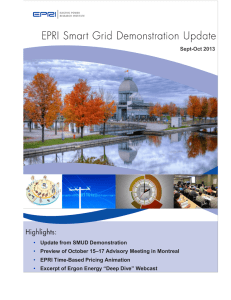
Efficient
Building
Systems
Utility
Communications
Internet
Consumer Portal
& Building EMS
Dynamic
Systems
Control
Distribution
Operations
Advanced
Metering
Renewables
PV
Control
Interface
Plug-In Hybrids
Data
Management
Distributed
Generation
& Storage
EPRI Smart Grid
Demonstration and CIM
Standards Development
Smart
End-Use
Devices
John J. Simmins
jsimmins@epri.com
865-218-8110
© 2009 Electric Power Research Institute, Inc. All rights reserved.
1
EPRI Smart Grid Demonstrations
• Deploying the Virtual
Power Plant
• Demonstrate Integration
and Interoperability
• Leverage information &
Communication
Technologies
• Integration of Multiple
Types of Distributed
Energy Resources (DER):
• Distributed Generation
• Renewable Generation
• Storage
• Demand Response
• Multiple Levels of Integration - Interoperability
© 2009 Electric Power Research Institute, Inc. All rights reserved.
2
Demonstration Approach & Objectives to
Enable Widespread Integration of DER
Market Operator
Transmission
Operator
Distribution Control
Center
External
corporations
Define information models and communications interfaces
– All Levels of distributed resource integration
Energy
Markets
Develop application guidelines, integration requirements and
standards for distributed resource integration.
Field Assessments to:
– Understand required systems and technologies for
distributed resource integration
Verify Smart Grid business case assumptions
– Benefits associated DER Integration
Security
Network Management
Data Management
DER
Integration
Shared Learning will Lend to Expandability, Scalability, and Repeatability
© 2009 Electric Power Research Institute, Inc. All rights reserved.
3
Smart Grid Demonstration - 19 Collaborators
(Utilities giving permission to list their names. 7/23/2009)
Wisconsin Public Service
Central Hudson Gas &
Electric
Ameren
ESB Networks
KCP&L
Southwest Power Pool
Salt River Project
Con Edison
Electricité de France
FirstEnergy / JCP&L
PNM Resources
PSE&G
TVA
AEP
Entergy
Duke
Southern
Collaborator
Collaborator / Host-Site
© 2009 Electric Power Research Institute, Inc. All rights reserved.
4
Smart Grid Demonstration Host-Site Criteria
1. Integration of Multiple Distributed Resource Types
2. Connect retail customers to wholesale conditions
3. Integration with System Planning & Operations
4. Critical Integration Technologies and Standards
5. Compatibility with EPRI’s Initiative and Approach
6. Funding requirements and leverage of other
funding resources
© 2009 Electric Power Research Institute, Inc. All rights reserved.
5
Objectives of the Smart Grid Demonstrations
• Provide real world experience with a new technology
• Characterize the economics of broader deployment
• Help characterize the benefits of the technology within the
overall infrastructure
• Identify integration requirements of the technology with
the overall architecture (especially compliance with
standards such as the Common Information Model)
• Identify work force requirements (manpower
requirements, skill sets, training, etc.) associated with
broader deployment, operation, and maintenance
• Provide the basis for overall cost/benefit assessment of
the technology application within the overall architecture.
© 2009 Electric Power Research Institute, Inc. All rights reserved.
6
The Industry Smart Grid Demonstrations
© 2009 Electric Power Research Institute, Inc. All rights reserved.
7
Con Edison
Interoperability of Demand Response Resources
© 2009 Electric Power Research Institute, Inc. All rights reserved.
8
FirstEnergy / Jersey Central Power & Light
Integrated Distributed Energy Resources (IDER)
© 2009 Electric Power Research Institute, Inc. All rights reserved.
9
PNM
High-Penetration PV thru Grid Automation and Demand Response
© 2009 Electric Power Research Institute, Inc. All rights reserved.
10
EDF
PREMIO: Distributed Energy Resources Aggregation & Management
© 2009 Electric Power Research Institute, Inc. All rights reserved.
11
AEP
Virtual Power Plant Simulator (VPPS)
© 2009 Electric Power Research Institute, Inc. All rights reserved.
12
Coordinated EPRI Engagement Across Multiple
Programs
#
NIST Priority
Action Plan
1
IP for the Smart Grid
2
Wireless Communications for the
Smart Grid
3
Common Pricing Model
4
Common Scheduling Mechanism
5
Standard Meter Data Profiles
6
Common Semantic Model for Meter
Data Tables
7
Electric Storage Interconnection
Guidelines
8
CIM for Distribution Grid
Management
9
Standard Demand Response
Signals
10
Standard Energy Usage Information
11
Common Object Models for Electric
Transportation
12
IEC 61850 Objects/DNP3 Mapping
13
Time Synchronization, IEC 61850
Objects/IEEE C37.118
Harmonization
14
Transmission and Distribution
Power Systems Model Mapping
© 2009 Electric Power Research Institute, Inc. All rights reserved.
Electric
Transportation
Energy Efficiency
Efficient T&D
IntelliGrid
Smart Grid
Distribution
(161)
Demo
Initiative
Smart Distribution
Applications
Renewable Integration
Energy Storage
13
Distribution Architecture for a Smart Grid
Distribution Roadmap
© 2009 Electric Power Research Institute, Inc. All rights reserved.
Slide
14
14
Summary – Smart Grid Demos and CIM
• Maximize the use of standards, particularly CIM in each Demonstration
Project.
• Provide feedback on the successes and challenges of CIM
implementation.
• Promote interoperability tests. Needed now more than ever.
– Multispeak – CIM harmonizations
– Inter-operability among Advanced Metering Infrastructure (AMI)
head-end systems, Meter Data Management (MDM) systems,
and Outage Management Systems (OMS).
– Topology and electrical model compatibility between GIS and
OMS and/or SCADA/DMS using the Common Distribution Power
System Model (CDPSM).
• Promote other programs such as research into cleaning up GIS data.
© 2009 Electric Power Research Institute, Inc. All rights reserved.
15
Questions?
© 2009 Electric Power Research Institute, Inc. All rights reserved.
16





